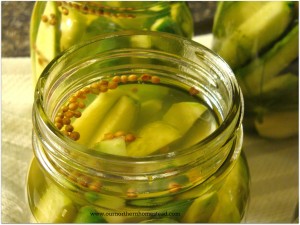In light of recent news of a jam being responsible for the food poisoning episode last week at Toronto’s annual CNE (Canadian National Exhibition), it shows that even a commercial maker of jam’s and jellies can slip up when making their product.
Home cooks must follow a very strict and rigid set of rules when canning/preserving food for their families to avoid serious illness contracted from bacteria as a result of improper food handling.
I preserve a lot of food for my family, most of it being different types of jams, jellies and tomato products. I have always taken every precaution in order to ensure food safety for my family. There are guidelines to follow for canning and preserving food and I would like to remind everyone that preserves their own food, that these quidelines were created for our own safety and well being.
Rules of Canning and Preserving
1. Always start with the freshest ingredients, if it is produce, ensure it is washed and inspected for bad spots or mould. Toss any and all damaged product.
2. Ensure your work space, utensils and yourself (hands especially) are spic n’ span clean prior to beginning.
3. Sterilize all canning jars, lids and screw bands as per manufacturers instructions. This cannot be stressed enough.
4. Follow recipes to the letter, do not be tempted to omit an item (especially an acid called for in a recipe) because you either forgot to buy it or ran out. Canning recipes are tested until perfect with ingredients being listed that way for a reason. Ensure the product is cooked to the exact specifications called for.
5. Fill jars with prepared product to the required headspace, wipe rims with a clean cloth before placing on the lids. Screw bands down until fingertip tight.
6. Process jars in a water canning bath for the exact time called for in the recipe, same with pressure cookers, do not be tempted to shorten the time because you are running out of time.
7. Ensure all jars are properly sealed before storing. Any jars that have not sealed, either re-process or store in the fridge and use within a week.
There are several Home Canning books available from the maker’s of the glass canning jars (Ball and Bernardin), so do yourself a favour and head to your local bookstore to obtain one, better safe than sorry is my motto!
We live in a highly civilized country with the technology and know-how to ensure we do not eat contaminated food. The 150 or so people that fell ill at the CNE deserved to be served food that was safe and it is disappointing to see things like this still happen in our country.
Following these tried and true rules will ensure your family is safe from food borne illnesses and not become another statistic.
Ok, the lecture is over. You may continue on with your day.


When I ‘used’ to do canning, I followed the sterilization techniques listed and then some. Never had a problem. Great list though, Deborah. I, like yourself, cannot stress how important all your points are.
Betty
That is what I like to hear 🙂
I too am careful about sterilizing and have found a better way to do a lot of jars at a time without a mess. Long time canning friends showed me.
I wash all jars in the dishwasher, then put them on cookie trays and pop them into a 250 degree oven for 10-15 minutes. They are sterilized and stay hot until needed.
The lids are still done the old way, in a pan of water. And, if you haven’t done so, go out and buy yourself a magnetic lid picker-upper. It’s a plastic stick with a magnet at the end and just marvelous for picking up lids out of hot water. Best invention ever!
My sister-in-law also showed me how to save on buying jar rings.
After the jars are sealed, (the lids caved in), and cooled off, she took the outside rings off to use on more jars. The lids stay sealed because the outside air pressure keeps them tight after the hot air inside cools off.
When I went into her basement and saw all the ringless jars, I couldn’t believe they stayed sealed and she had to show me by popping a lid. It was stuck fast!
So, I now just go and buy lids and not the rings, unless my rings get corroded or rusty.
A few years ago I found white plastic jar lids to use on canning jars, after they are opened, instead of the rings and lids. I now have both the small and wide lids and they look so much better than the metal ones, plus are easy to clean.
I sure am enjoying the canning recipes you are sharing here and have copied them to make later, (after my granddaughter leaves).
Thanks Deb 🙂
You are welcome Lydia! 🙂 I hope you enjoy the recipes, let me know what you think of them. I also sterilize my jars in the oven, have been for years, it is quick and less messy. Removing the rings I knew about from a friend of mine out west, and the rings also make good racks in a pinch if they are tied together with electric wire ties (the plastic ones). I need to get some of those white lids, they do sound much better to use on already opened jars, thus freeing up rings for further canning 🙂